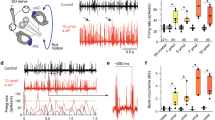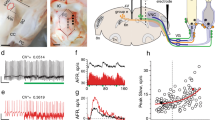Abstract
Vestibulo-ocular reflexes (VOR) are mediated by three-neuronal brainstem pathways that transform semicircular canal and otolith sensory signals into motor commands for the contraction of spatially specific sets of eye muscles. The vestibular excitation and inhibition of extraocular motoneurons underlying this reflex is reciprocally organized and allows coordinated activation of particular eye muscles and concurrent relaxation of their antagonistic counterparts. Here, we demonstrate in isolated preparations of Xenopus laevis tadpoles that the discharge modulation of superior oblique motoneurons during cyclic head motion derives from an alternating excitation and inhibition. The latter component is mediated exclusively by GABA, at variance with the glycinergic inhibitory component in lateral rectus motoneurons. The different pharmacological profile of the inhibition correlates with rhombomere-specific origins of vestibulo-ocular projection neurons and the complementary segmental abundance of GABAergic and glycinergic vestibular neurons. The evolutionary conserved rhombomeric topography of vestibulo-ocular projections makes it likely that a similar pharmacological organization of inhibitory VOR neurons as reported here for anurans is also implemented in mammalian species including humans.


Similar content being viewed by others
References
Angelaki DE, Cullen KE (2008) Vestibular system: the many facets of a multimodal sense. Annu Rev Neurosci 31:125–150
Straka H, Fritzsch B, Glover JC (2014) Connecting ears to eye muscles: evolution of a ‘simple’ reflex arc. Brain Behav Evol 83:162–175
Graf W, Simpson JI (1981) The relations between the semicircular canals, the optic axis, and the extraocular muscles in lateral-eyed and frontal-eyed animals. In: Fuchs A, Becker W (eds) Progress in oculomotor research, developments in neuroscience, vol 12. Elsevier, New York, pp 411–420
Branoner F, Chagnaud BP, Straka H (2016) Ontogenetic development of vestibulo-ocular reflexes in amphibians. Front Neural Circuits 10:91
Straka H, Baker R (2013) Vestibular blueprint in early vertebrates. Front Neural Circuits 7:182
Graf W, Spencer R, Baker H, Baker R (1997) Excitatory and inhibitory vestibular pathways to the extraocular motor nuclei in goldfish. J Neurophysiol 77:2765–2779
Spencer RF, Wenthold RJ, Baker R (1989) Evidence for glycine as an inhibitory neurotransmitter of vestibular, reticular, and prepositus hypoglossi neurons that project to the cat abducens nucleus. J Neurosci 9:2718–2736
Straka H, Dieringer N (1993) Electrophysiological and pharmacological characterization of vestibular inputs to identified frog abducens motoneurons and internuclear neurons in vitro. Eur J Neurosci 5:251–260
Dietrich H, Glasauer S, Straka H (2017) Functional organization of vestibulo-ocular responses in abducens motoneurons. J Neurosci 37:4032–4045
Ito M, Highstein SM, Tsuchiya T (1970) The postsynaptic inhibition of rabbit oculomotor neurons by secondary vestibular impulses and its blockage by picrotoxin. Brain Res 17:520–523
Obata K, Highstein SM (1970) Blocking by picrotoxin of both vestibular inhibition and GABA action on rabbit oculomotor neurons. Brain Res 18:538–541
Precht W, Baker R, Okada Y (1973) Evidence for GABA as the synaptic transmitter of the inhibitory vestibulo-ocular pathway. Exp Brain Res 18:415–428
De la Cruz RR, Pastor AM, Martinez- Guijarro FJ, Lopez-Garcia C, Delgado-Garcia JM (1992) Role of GABA in the extraocular motor nuclei of the cat: a postembedding immunocytochemical study. Neuroscience 51:911–929
Zeeh C, Mustari MJ, Hess BJM, Horn AKE (2015) Transmitter inputs to different motoneuron subgroups in the oculomotor and trochlear nucleus in monkey. Front Neuroanat 9:95
Jentsch TJ (1996) Chloride channels: a molecular perspective. Curr Opin Neurobiol 6:303–310
Nieuwkoop PD, Faber J (1994) Normal Table of Xenopus Laevis (Daudin): a systematical and chronological survey of the development from the fertilized egg till the end of metamorphosis. Garland Pub, New York
Branoner F, Straka H (2015) Semicircular canal-dependent developmental tuning of translational vestibulo-ocular reflexes in Xenopus laevis. Dev Neurobiol 75:1051–1067
Straka H, Baker R, Gilland E (2001) Rhombomeric organization of vestibular pathways in larval frogs. J Comp Neurol 437:42–55
Díaz C, Glover JC (2002) Comparative aspects of the hodological organization of the vestibular nuclear complex and related neuron populations. Brain Res Bull 57:307–312
Straka H, Holler S, Goto F, Kolb FP, Gilland E (2003) Differential spatial organization of otolith signals in frog vestibular nuclei. J Neurophysiol 90:3501–3512
Reichenberger I, Straka H, Ottersen OP, Streit P, Gerrits NM, Dieringer N (1997) Distribution of GABA, glycine and glutamate immunoreactivities in the vestibular nuclear complex of the frog. J Comp Neurol 377:149–164
Walberg F, Ottersen OP, Rinvik E (1990) GABA, glycine, aspartate, glutamate and taurine in the vestibular nuclei: an immunocytochemical investigation in the cat. Exp Brain Res 79:547–563
Büttner-Ennever JA (1992) Patterns of connectivity in the vestibular nuclei. Ann NY Acad Sci 656:363–378
Pasqualetti M, Díaz C, Renaud J-S, Rijli FM, Glover JC (2007) Fate-mapping the mammalian hindbrain: segmental origins of vestibular projection neurons assessed using rhombomere-specific Hoxa2 enhancer elements in the mouse embryo. J Neurosci 27:9670–9681
Jembrek MJ, Vlainic J (2015) GABA receptors: pharmacological potential and pitfalls. Curr Pharm Des 21:4943–4959
Acknowledgements
The authors acknowledge financial support from the German Science Foundation (CRC 870; STR 478/3-1) and the German Federal Ministry of Education and Research under the Grant code 01 EO 0901. The authors thank Kathrin Gensberger for the technical support in part of the experiments and Dr. Boris Chagnaud for constructive comments on the manuscript.
Author information
Authors and Affiliations
Corresponding author
Ethics declarations
Conflicts of interest
The authors declare no competing financial interests.
Ethical standard
The study was performed in accordance with the ethical standards statement.
Additional information
This manuscript is part of a supplement sponsored by the German Federal Ministry of Education and Research within the funding initiative for integrated research and treatment centers.
Rights and permissions
About this article
Cite this article
Soupiadou, P., Branoner, F. & Straka, H. Pharmacological profile of vestibular inhibitory inputs to superior oblique motoneurons. J Neurol 265 (Suppl 1), 18–25 (2018). https://doi.org/10.1007/s00415-018-8829-4
Received:
Revised:
Accepted:
Published:
Issue Date:
DOI: https://doi.org/10.1007/s00415-018-8829-4




